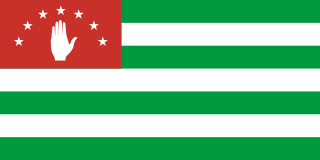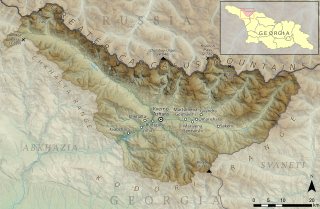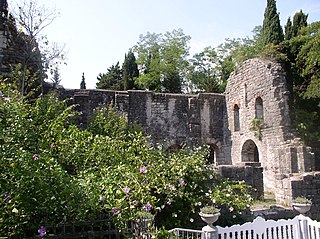This article relies largely or entirely on a single source .(November 2021) |


The Seven Shrines of the Abkhaz in Abkhazia [1] are considered holy in the Abkhaz traditional religion and are known and respected by most Abkhazians.
This article relies largely or entirely on a single source .(November 2021) |


The Seven Shrines of the Abkhaz in Abkhazia [1] are considered holy in the Abkhaz traditional religion and are known and respected by most Abkhazians.
| Location | District | |
|---|---|---|
| Dydrypsh mountain | near Achandara village | Gudauta |
| Lykhnashta - Lykhny square | Lykhny | Gudauta |
| Ldzaa-nykha grove | near Lidzava and Pitsunda | Gagra |
| Inal-kuba mountain | near Pskhu village | Sukhumi |
| Adagua mountain shrine | near Tsabal village | Gulripshi |
| Lashkendar mountain | near Tkvarcheli | Tkvarcheli |
| Elyr-nykha shrine | Ilori village | Ochamchira |

Gali is a town in Abkhazia 77 km southeast of Sukhumi. It is the centre of Gali District and was in the United Nations security zone prior to the Russian veto of the UNOMIG Mission in 2009. As of 2011 the town has a population of 7 605 inhabitants.

Gudauta is a town in Abkhazia, Georgia, and a centre of the eponymous district. It is situated on the Black Sea, 37 km northwest of Sukhumi, the capital of Abkhazia. It is the namesake for the Gudauta Bay.

The flag of the Republic of Abkhazia was created in 1991 by Valeri Gamgia. It was officially adopted on 23 July 1992.
Chuburkhinji is a village in the Gali Municipality of Abkhazia, Georgia. As is the case in the rest of the district its population is almost exclusively Georgian.

Lykhny is a village in the Gudauta District of Abkhazia, a disputed region on the Black Sea coast.

Upper Abkhazia, commonly known by its administrative name, Azhara Municipality is a geographical term and municipality of the Government of the Autonomous Republic of Abkhazia. The term was first introduced in 2006, to denote the northeastern part of the disputed territory of Abkhazia, that had remained under Georgian control after the 1992 War in Abkhazia. From September 2006 to August 2008 its main village, Chkhalta, hosted the Government of the Autonomous Republic of Abkhazia and was the seat of the Azhara municipal community. This situation came to an end in the Battle of the Kodori Valley in August 2008, when Upper Abkhazia was conquered by the Russo-Abkhazia armies, which had already controlled the rest of Abkhazia. Even though the area was no longer controlled by Georgia, the Georgian Government kept its municipal status as a sign of not recognizing any changes to the Abkhazian administrative divisions made by the breakaway republic. The current seat of the municipal government-in-exile is Tbilisi.

Tkvarcheli is a town in Abkhazia. It is situated on the river Ghalidzga (Aaldzga) and a railway connects it with Ochamchire. Akarmara, an area within the town, is a ghost town with abandoned apartments and factories which became uninhabited in the early 1990s due to the War in Abkhazia (1992-1993), and is home to just 35 residents today.
Gulripshi is an urban settlement in Abkhazia. It is located 12 km from Sukhumi, and is the capital of Gulripshi District.

Bzyb or Bzipi is an urban-type settlement located in the Gagra District of Abkhazia, Georgia. Next to the river Bzyb. There is a 9th-10th-century church, now in ruins and a medieval fortress nearby. The town became less important when the fortress was destroyed and the town passed into the control of the clan of Inal-Ipa, which perhaps branched off around 1730 from Abkhazia's princely house, the Shervashidze.

Gantiadi, or Tsandrypsh, is an urban-type settlement on the Black Sea coast in Georgia, in the Gagra District of Abkhazia, 5 km from the Russian border.

Abkhazia, officially the Republic of Abkhazia, is a partially recognised state in the South Caucasus, on the eastern coast of the Black Sea, at the intersection of Eastern Europe and West Asia. It covers 8,665 square kilometres (3,346 sq mi) and has a population of around 245,000. Its capital and largest city is Sukhumi.
Kvemo Barghebi is a village in Gali Municipality of Georgia. As is the case in the rest of the district its population is almost exclusively Georgian.

Gali District is one of the districts of Abkhazia. Its capital is Gali, the town by the same name. The district is smaller than the eponymous one in the de jure subdivision of Georgia, as some of its former territory is now part of Tkvarcheli District, formed by de facto Abkhaz authorities in 1995.
Bedia is a village in the Tkvarcheli District of Abkhazia. As a result of the Georgian dispute over the sovereignty of Abkhazia, Georgia claims the village as part of its Gali Municipality. As of 2011, the village had a population of 288, of which 85.5% of them were ethnic Georgians and 13.6% were ethnic Abkhaz, with 2 others living in the village.
Salme is a village in Abkhazia, Georgia. It was founded in 1884 by Estonian resettlers from Kuusalu, Governorate of Estonia. In 1989 the village had 1659 inhabitants, mostly Estonians, Armenians, Georgians and Russians. Nowadays, most of the inhabitants are Abkhaz, as most of the Estonians were repatriated back to Estonia during the 1992-1993 Georgian-Abkhaz war. The village has subsequently been renamed Psou by Abkhaz authorities after the Psou River.
Alakhadzi is a village in the Gagra District of Abkhazia.
Mikelrypsh is a village in the Gagra District of Abkhazia.
Ghvada is a village in the Ochamchira District of Abkhazia, Georgia.
Nabakevi Church is a church in the village of Nabakevi, Gali Municipality, Autonomous Republic of Abkhazia, Georgia. The church was built in the Middle Ages.
Achigvara or Achguara is a village in the Ochamchira District of Abkhazia, Georgia. The 2011 Abkhazian census recorded a population of 1,032 people.
Крылов, А. Б. (1999). Постсоветская Абхазия (Традиции. Религии. Люди). Москва: Российская Академия Наук. Институт Востоковедения. pp. 127–213.